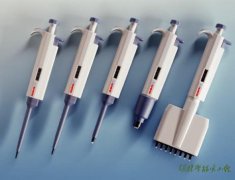海拉细胞(英语:Hela Cells,有时音译为海乐细胞,亦称实验用增殖表皮癌细胞)是生物学与医学研究中使用的一种细胞,源自一位美国妇女海莉耶塔·拉克斯(Henrietta Lacks)的子宫颈癌细胞的细胞系。这名美国妇女在1951年死于该癌症。为了让拉克斯保持匿名,此细胞株原宣称是依“Helen Lane”命名。HeLa细胞系被视为“不死的”(即不同于其他一般的人类细胞,此细胞株不会衰老致死,并可以无限分裂下去),至今都被不间断的培养。此细胞系跟其他癌细胞相比,增殖异常迅速。
海拉细胞系被George Gey分送给众研究单位(并未通知拉克斯本人也未得到她的许可),并用作癌症模式细胞(model cancer cells)研究。HeLa细胞系也被用作研究细胞信号传导(cellular signal transduction)。
海拉细胞系是被人类乳突病毒第18型(Human papillomavirus 18)转化的,和正常子宫颈细胞有许多不同。
已证实海拉细胞系难以控制。此细胞系有时会污染同一实验室的其他细胞培养物(cell culture),干扰生物学的研究。污染程度难以估计,因为研究人员很少检定已确立细胞系的本质和纯度。据说有相当数目的体外细胞系(in vitro cell lines)其实就是HeLa细胞系,因为原先的细胞株已被快速增殖的HeLa细胞系污染物取代了。
有学者认为此细胞系是一新的物种,因为此细胞株能自行繁殖和散布。在1991年此细胞株被命名为“Helacyton gartleri”。
海拉细胞生长奇快,甚至超越一般癌细胞。海乐细胞经历细胞分裂时可维持端粒酶活性以维持端粒长度,一般细胞的端粒会随着老化而变短,终至细胞死亡。海拉细胞利用此机制避开海佛烈克极限(Hayflick limit)。
2013年8月7日,美国国家卫生研究院宣布,已和海莉耶塔·拉克斯的后代达成协议。拉克斯的孙儿与曾孙女将参与决定,那一单位的生医研究人员可以取得海拉细胞系的基因体数据库。此协议可保护拉克斯家属的权益。

The cells were propagated by George Otto Gey shortly before Lacks died of her cancer in 1951. This was the first human cell line to prove successful in vitro, which was a scientific achievement with profound future benefit to medical research. Gey freely donated both the cells and the tools and processes his lab developed to any scientist requesting them, simply for the benefit of science. Neither Lacks nor her family gave Lacks's physician permission to harvest the cells, but, at that time, permission was neither required nor customarily sought. The cells were later commercialized, although never patented in their original form. Then, as now, there was no requirement to inform a patient, or their relatives, about such matters because discarded material, or material obtained during surgery, diagnosis, or therapy, was the property of the physician and/or medical institution (this currently requires ethical approval and patient consent in the UK). This issue and Lacks's situation was brought up in the Supreme Court of California case of Moore v. Regents of the University of California. The court ruled that a person's discarded tissue and cells are not their property and can be commercialized.
At first, the cell line was said to be named after a "Helen Lane" or "Helen Larson", in order to preserve Lacks's anonymity. Despite this attempt, her real name was used by the press within a few years of her death. These cells are treated as cancer cells, as they are descended from a biopsy taken from a visible lesion on the cervix as part of Lacks's diagnosis of cancer. A debate still continues on the classification of the cells.[citation needed]
HeLa cells, like other cell lines, are termed "immortal" in that they can divide an unlimited number of times in a laboratory cell culture plate as long as fundamental cell survival conditions are met (i.e., being maintained and sustained in a suitable environment). There are many strains of HeLa cells as they continue to mutate in cell cultures, but all HeLa cells are descended from the same tumor cells removed from Lacks. It has been estimated that the total number of HeLa cells that have been propagated in cell culture far exceeds the total number of cells that were in Henrietta Lacks's body.
HeLa cells were used by Jonas Salk to test the first polio vaccine in the 1950s. HeLa cells were observed to be easily infected by poliomyelitis, causing infected cells to die. This made HeLa cells highly desirable for polio vaccine testing since results could be easily obtained. A large volume of HeLa cells were needed for the testing of Salk’s polio vaccine, prompting the National Foundation for Infantile Paralysis (NFIP) to find a facility capable of mass-producing HeLa cells. In the spring of 1953, a cell culture factory was established at Tuskegee University to supply Salk, as well as other labs, with HeLa cells. Less than a year later, Salk’s vaccine was ready for human trials.
HeLa cells were also the first human cells to be successfully cloned in 1955 by Theodore Puck and Philip I Marcus at the University of Colorado, Denver.
Since that time, HeLa cells have been used for "research into cancer, AIDS, the effects of radiation and toxic substances, gene mapping, and many other scientific pursuits". According to author Rebecca Skloot, by 2009, "more than 60,000 scientific articles had been published about research done on HeLa, and that number was increasing steadily at a rate of more than 300 papers each month."
HeLa cells have been used in testing how parvo virus infects cells of humans, HeLa, dogs, and cats. These cells have also been used to study viruses such as the Oropouche virus (OROV). OROV causes the disruption of cells in cultured cells where cells begin to degenerate shortly after they are infected causing viral induction of apoptosis. HeLa cells have been used in the study of the expression of the papillomavirus E2 and apoptosis. HeLa cells have also been used to study canine distemper virus' ability to induce apoptosis in cancer cell lines. This virus' ability to induce apoptosis could play an important role in developing treatments for tumor cells resistant to radiation and chemotherapy.
HeLa cells have also been used in a number of cancer studies including those involving sex steroid hormones such as Estradiol, estrogen, and estrogen receptors along with estrogen like compound such as Quercetin and its cancer reducing properties. There have also been studies on HeLa cells, the effects of flavonoids and antioxidants with estradiol on cancer cell proliferation.
HeLa cells were used to investigate the phytochemical compounds and the fundamental mechanism of the anticancer activity of the ethanolic extract of mango peel (EEMP). EEMP was found to contain various phenolic compounds and to activate death through apoptosis of human cervical malignant HeLa cells which suggests EEMP may help to prevent cervical cancer as well as other types of cancers.
In 2011, HeLa cells were used in tests of novel heptamethine dyes IR-808 and other analogs which are currently being explored for their unique uses in medical diagnostics, the development of theranostics, the individualized treatment of cancerous patients with the aid of PDT, co-administration with other drugs, and irradiation.
HeLa cells have been used in research involving Fullerenes to induce apoptosis as a part of Photodynamic therapy.
HeLa cells have also been used in in vitro cancer research using cell lines.
HeLa cells have been used to define cancer markers in RNA, and have been used to establish an RNAi Based Identification System and Interference of Specific Cancer Cells.

量程的调节 调节量程时,如果要从大体积调为小体积,则按照正常的调节方法,逆时针旋转旋钮即可;但如果要从小体积调为大体积时,则...
1 什么是扫描电子显微镜(SEM) Scanning Electron Microscope(SEM)扫描型电子显微镜是由真空系统、 高压电源、高灵敏度增幅器获取样品表面图像的...

环己烷(CYH)、环己酮(CYC)、二丙酮醇(DAA)、四氢呋喃(THF)、二甲基甲酰胺(DMF)、二甲亚砜(DMSO)、甲基丙烯酸甲酯(MMA). (A)酯类 ESTERS 乙酸甲酯 MA...

Two-dimensional thin-layer chromatography in the analysis of secondary plant metabolites ukas z Ciela , Monika Waksmundzka-H ajnos , Drugs, derived from medicinal plants, have been ...